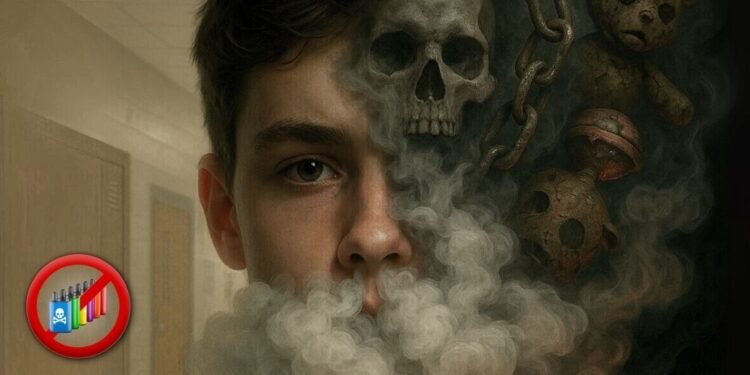What started as a “healthier” alternative to smoking has turned into a full-blown youth epidemic. Vaping—once marketed as a harm-reduction tool for adults—has quietly hooked a new generation of teenagers worldwide, including in the Philippines.
Flavored, colorful, and accessible almost anywhere, vapes have become a lifestyle item disguised as wellness tech.
But behind the clouds of mango ice and cotton candy vapor is a growing body of evidence: vaping is dangerous, addictive, and aggressively marketed to teens. In the Philippines, where regulation remains loose and education around nicotine is minimal, the damage may already be setting in.
The Numbers Are Worse Than You Think
Globally, teen vaping peaked during the pandemic—but the effects are still playing out. According to a 2024 study published in The Lancet Regional Health, around 16.8% of teens worldwide have tried vaping before turning 18. In the United States, over 5.9% of high school students are regular e-cigarette users as of 2024.
The Philippines is following the same pattern. Data from the Global Youth Tobacco Survey reveals that 14% of Filipino students aged 13–15 now use e-cigarettes—amounting to over 1.2 million minors. Even more concerning, more than half believe vaping is harmless, reflecting both poor awareness and predatory advertising.
Designed to Hook Kids
The rise of vaping among teens isn’t accidental—it’s engineered. Disposable vapes like Elf Bar, Waka, and Lost Mary are sold in neon colors, designed like tech gadgets, and flavored like candy store products. Strawberry ice. Bubblegum. Lychee mango. These aren’t intended for lifelong Marlboro smokers trying to quit. They’re designed to appeal to 14-year-olds scrolling TikTok.
A report by WHFoods.org found that 87% of youth vape users prefer flavored e-cigarettes. And because these devices are often nicotine-dense—with some containing more nicotine than an entire pack of cigarettes—they create dependency faster and more powerfully than most teens realize.
The Health Damage Is Already Here
While marketed as “cleaner” than traditional smoking, vapes are anything but safe. Between 2019 and 2020, the U.S. Centers for Disease Control (CDC) recorded more than 2,800 cases of e-cigarette or vaping-associated lung injury (EVALI). Many were teens. Some were hospitalized for weeks. A few died.
Chemicals commonly found in vape aerosols include formaldehyde, diacetyl (linked to “popcorn lung”), and heavy metals like lead. Long-term effects are still being studied, but early data is clear: regular vaping harms lung function, reduces immune response, and increases the risk of asthma and bronchitis—especially in adolescents.
Social Media Made It Cool
Platforms like TikTok, Instagram, and YouTube helped supercharge the vaping trend. Hashtags like #VapeTricks and #CloudCheck have racked up hundreds of millions of views, most without any age restriction or health warnings. Studies show teens who spend over 7 hours a day on social media are four times more likely to vape than those who don’t.
With influencer culture, sponsored vape content, and viral challenges, social media has turned a public health hazard into a performance. And in the Philippines, where many teens have unrestricted online access, this effect is multiplied.
PH Vape Laws Look Strong—but Fall Apart in Reality
In 2022, the Philippines passed the Vaporized Nicotine and Non-Nicotine Products Regulation Act (RA 11900). On paper, it restricted the sale of e-cigarettes to those over 18, banned certain ads, and aimed to standardize labeling.
In practice, enforcement is close to nonexistent.
Flavored vapes are still sold in sari-sari stores, school perimeters, and on major e-commerce platforms. Age checks are often skipped. Online influencers continue promoting disposable brands. The law has structure—but no teeth.
Why This Hits the Philippines Harder
Nicotine affects all teens—but the Philippine context makes it worse. Public health funding is limited. Anti-smoking education in schools is rare. Access to medical treatment for nicotine dependency is scarce. Add to that a young, social media-native population with high mobile screen time, and the result is a generation uniquely vulnerable to addiction.
Nicotine rewires the developing brain—especially in adolescents under 25. It impacts memory, decision-making, and impulse control. And worse, studies show that teen vapers are nearly three times more likely to start smoking traditional cigarettes within a few years.
Other Countries Are Moving Fast—Why Aren’t We?
In 2024, Australia banned all non-prescription vape sales. The United Kingdom is moving to restrict flavored disposables. The U.S. FDA is pulling specific products off shelves.
Meanwhile, in the Philippines, flavored vapes remain widely available, promoted on social media, and openly sold to minors. Without urgent intervention, we risk falling behind—and putting more young lives in danger.
Final Word: This Wasn’t an Accident. It Was Engineered.
The rise of youth vaping is the result of targeted marketing, regulatory gaps, and silence. It’s not a mistake—it’s strategy. And unless we fight back, the health consequences will follow us for decades.
The Philippines needs stronger laws, stricter enforcement, and smarter education—now. Because behind every fruit-flavored cloud is a generation quietly being hooked on nicotine before they can vote.
Sources:












